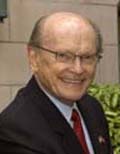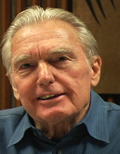Distinguished Achievement - Donald E. Petersen
 Don Petersen built a 41-year career at the Ford Motor Company, moving steadily up the ranks to become president in 1980 and chairman of the board and CEO in 1985. He is one of a select number of UW graduates to head a Fortune 500 company. Petersen changed the culture at Ford by focusing on inclusive teamwork and the concept that "quality is job #1." He led a struggling company through a spectacular turn-around, leaving Ford in robust and vigorous shape at the time of his retirement in 1990. His achievements and management style won international recognition, and Chief Executive magazine honored him as “CEO of the Year” in 1989. Petersen served on the boards of several major corporations including The Boeing Company, Hewlett-Packard, and Dow Jones Co., and is a member of the National Academy of Engineering. He also authored a best-selling book, A Better Idea: Refining the Way Americans Work. Throughout his career he has been an active volunteer and passionate advocate for improving our secondary and higher education systems. He holds a BSME from the University of Washington and an MBA from Stanford.
Don Petersen built a 41-year career at the Ford Motor Company, moving steadily up the ranks to become president in 1980 and chairman of the board and CEO in 1985. He is one of a select number of UW graduates to head a Fortune 500 company. Petersen changed the culture at Ford by focusing on inclusive teamwork and the concept that "quality is job #1." He led a struggling company through a spectacular turn-around, leaving Ford in robust and vigorous shape at the time of his retirement in 1990. His achievements and management style won international recognition, and Chief Executive magazine honored him as “CEO of the Year” in 1989. Petersen served on the boards of several major corporations including The Boeing Company, Hewlett-Packard, and Dow Jones Co., and is a member of the National Academy of Engineering. He also authored a best-selling book, A Better Idea: Refining the Way Americans Work. Throughout his career he has been an active volunteer and passionate advocate for improving our secondary and higher education systems. He holds a BSME from the University of Washington and an MBA from Stanford.
Entrepreneurial Excellence - Frank D. Robinson
 Frank Robinson was nine years old when a photo of Igor Sikorsky taking off in a helicopter sparked the dreams for his life’s work. Early in his career he held design and engineering jobs at six helicopter companies, including Cessna, Bell, and Hughes. Unable to get backing for his idea to build a low-cost civilian helicopter, in 1973 he established his own firm in Southern California, Robinson Helicopter Company. He set up drafting tables in his living room and a workshop in the garage and mortgaged his home to fund construction of a prototype. In less than two years he moved the company to a site near the Torrance airfield. After his two-seat R22 went into production it became the top-selling civilian helicopter for individuals and flight schools. Police agencies, TV stations, and diverse commercial enterprises operate the four-seat R44. RCH now employs 1200 people and for two decades has held top ranking as the world’s largest manufacturer of commercial helicopters, earning Robinson recognition as "the Henry Ford of helicopters." His honors include the Howard Hughes Memorial Award and induction as a Hall of Fame "Legend" by Aviation Week & Space Technology. He holds a BSME from the University of Washington and received the college’s Distinguished Alumnus Award in 1991.
Frank Robinson was nine years old when a photo of Igor Sikorsky taking off in a helicopter sparked the dreams for his life’s work. Early in his career he held design and engineering jobs at six helicopter companies, including Cessna, Bell, and Hughes. Unable to get backing for his idea to build a low-cost civilian helicopter, in 1973 he established his own firm in Southern California, Robinson Helicopter Company. He set up drafting tables in his living room and a workshop in the garage and mortgaged his home to fund construction of a prototype. In less than two years he moved the company to a site near the Torrance airfield. After his two-seat R22 went into production it became the top-selling civilian helicopter for individuals and flight schools. Police agencies, TV stations, and diverse commercial enterprises operate the four-seat R44. RCH now employs 1200 people and for two decades has held top ranking as the world’s largest manufacturer of commercial helicopters, earning Robinson recognition as "the Henry Ford of helicopters." His honors include the Howard Hughes Memorial Award and induction as a Hall of Fame "Legend" by Aviation Week & Space Technology. He holds a BSME from the University of Washington and received the college’s Distinguished Alumnus Award in 1991.
Distinguished Service - Sally Jewell
 Sally Jewel is president and CEO of REI, a national outdoor-gear retailer named in 2006 as one of Fortune magazine’s 100 Best Companies to Work For. It is also the nation’s largest consumer cooperative with more than 2.8 million members. Jewell began her career as an engineer for Mobil Oil Corp., but then shifted gears and honed her business and management skills during 19 years in the banking industry. Executive positions included serving as president and CEO of West One Bank and president of Washington Mutual Bank’s commercial banking group. Throughout her career Jewell has been a role model for civic involvement and service, particularly in the arenas of education, conservation, and youth. She is an active alumna of the College of Engineering and is a member of the UW Board of Regents. She also is a founding board member and past president of the Mountains to Sound Greenway Trust and serves on the boards of the National Parks Conservation Association and the Initiative for Global Development. Among numerous honors for her community work, she received the 2005 Isabel Coleman Pierce Award from the YWCA. She earned a BSME from the University of Washington.
Sally Jewel is president and CEO of REI, a national outdoor-gear retailer named in 2006 as one of Fortune magazine’s 100 Best Companies to Work For. It is also the nation’s largest consumer cooperative with more than 2.8 million members. Jewell began her career as an engineer for Mobil Oil Corp., but then shifted gears and honed her business and management skills during 19 years in the banking industry. Executive positions included serving as president and CEO of West One Bank and president of Washington Mutual Bank’s commercial banking group. Throughout her career Jewell has been a role model for civic involvement and service, particularly in the arenas of education, conservation, and youth. She is an active alumna of the College of Engineering and is a member of the UW Board of Regents. She also is a founding board member and past president of the Mountains to Sound Greenway Trust and serves on the boards of the National Parks Conservation Association and the Initiative for Global Development. Among numerous honors for her community work, she received the 2005 Isabel Coleman Pierce Award from the YWCA. She earned a BSME from the University of Washington.
Early Career - Edward W. Felten
 Ed Felten is one of the nation’s most effective public advocates for technical innovation and secure computing. He is a professor of computer science and public affairs at Princeton University and directs the university’s Center for Information Technology Policy. His highly regarded research in computer security and privacy spans operating systems, programming languages, Internet software, and media and consumer products. In the policy arena he focuses on intellectual property and the impacts of technology regulation. His public advocacy work explores the ways in which government and industry attempt to limit technological innovation. Felten has been a lead expert witness in high-profile technology cases, has testified on technology issues before Senate and House committees, consults for government and industry, and has recently examined the security of electronic voting. In 2004 Scientific American named him to its list of 50 worldwide science and technology leaders. His academic honors have included an Alfred P. Sloan Fellowship and an NSF Young Investigator Award. Felten holds a BS in Physics from Cal Tech and an MS and PhD in computer science and engineering from the University of Washington.
Ed Felten is one of the nation’s most effective public advocates for technical innovation and secure computing. He is a professor of computer science and public affairs at Princeton University and directs the university’s Center for Information Technology Policy. His highly regarded research in computer security and privacy spans operating systems, programming languages, Internet software, and media and consumer products. In the policy arena he focuses on intellectual property and the impacts of technology regulation. His public advocacy work explores the ways in which government and industry attempt to limit technological innovation. Felten has been a lead expert witness in high-profile technology cases, has testified on technology issues before Senate and House committees, consults for government and industry, and has recently examined the security of electronic voting. In 2004 Scientific American named him to its list of 50 worldwide science and technology leaders. His academic honors have included an Alfred P. Sloan Fellowship and an NSF Young Investigator Award. Felten holds a BS in Physics from Cal Tech and an MS and PhD in computer science and engineering from the University of Washington.
Distinguished Group Achievement – Pioneers of the Passenger Jet
Maynard Pennell, Robert Hage, John Steiner, Lynn Olason, Joseph Sutter, Robert Brown, Richard FitzSimmons, and John Roundhill
This year the College of Engineering extends a special group award to recognize the significant achievements of eight UW Engineering alumni who led the development of the passenger jet at The Boeing Company. Maynard Pennell, Robert Hage, John Steiner, Lynn Olason, Joseph Sutter, Robert Brown, Richard FitzSimmons, and John Roundhill are outstanding engineers whose responsibilities ranged over aerodynamics, design, engineering, product development, manufacturing, and marketing for the models that continually advanced technology and became mainstays of commercial service worldwide. Over a span of more than five decades, these individuals (listed in chronological order) transformed the face of aviation.
Robert Hage
Bob Hage taught aeronautical engineering at the UW in the early 1940s and then served in the Army Air Corps as chief of aerodynamics at Wright Field in Ohio. He joined the Boeing Company in 1946, and along with Pennell and FitzSimmons conducted early studies that proved the feasibility of jet propulsion in civil aviation. In 1950 Boeing provided Hage a leave of absence to work in the Office of the Joint Chiefs of Staff in the Pentagon. Back at Boeing in 1954, he was a project engineer on the new 707 program. In 1959 he became a vice president with McDonnell Aircraft in St. Louis, and later guided development of the wide-body DC-10. Hage co-authored Airplane Performance, Stability and Control (1949), a classic text that is still in use. He earned a BSAE (’39) from the UW and an MS from MIT. Hage is a Fellow of the American Institute of Aeronautics and Astronautics (AIAA)M. Lynn Olason
Lynn Olason joined the Boeing Company at the close of World War II following Army Air Corps service conducting aerodynamics research in high-speed flows at Wright Field. At Boeing he worked with the original development team for the 707 and also on performance certification of the 727 and 737. He is one of the patent holders on the 737 for his engine/wing integration analysis. He later worked on the configuration and airline specifications for the 747 during its early stages of development, and then designed the cross-section of the 767. Olason’s management positions included chief of aerodynamics for all commercial airplanes, director of product development, and vice president/general manager of the 747 Division until his retirement in 1984. Olason earned his BSAE (’43) from the UW and is a Fellow of the AIAA.Joseph Sutter
Fresh out of the Navy at the end of World War II, Joe Sutter joined Boeing as an aerodynamicist. His engineering skills won him prominent design roles on the prototype for the 707, and later the 727 and 737. In 1965 he took on the enormous challenge of heading design of the world’s first jumbo jet. Sutter conceived the idea for the twin-aisle wide body, and shepherded the first 747 into production in 1970, earning him recognition as the “father of the 747.” He later directed development of the 757, 767, and 747-400, retiring in 1986 as executive vice president of Boeing Commercial Airplane Company. His many honors include the Wright Brothers Trophy, the U.S. Medal of Technology (presented by President Ronald Reagan), the Guggenheim Medal, election to the National Academy of Engineering, AIAA honorary fellowship, and the University of Washington’s Alumnus Summa Laude Dignatus award in 2001. Sutter earned his BSAE (’43) from the UW.Richard FitzSimmons
Dick FitzSimmons joined Boeing in 1946, assigned to preliminary design for jet propulsion in civil transports. He worked in partnership with Pennell and Hage on the role for jet propulsion in civil aviation. After six years of civil design studies, he proposed using the best civil design for the new KC-135, the tanker aircraft for the B-52. This design, in turn, led to the 707. FitzSimmons went on to sell 707s in the United States, then in Europe and Africa, and subsequently directed product research. In 1970 Boeing nominated him to head the aeronautics staff of the National Aeronautics and Space Council in the Executive Office of the President. McDonnell-Douglas hired him as director of advanced supersonic transports in 1972. He later directed advanced program engineering for the MD-11, C-17, MD-80 derivatives, and all research and development. His many honors include citations from the White House, NASA, and the FAA. FitzSimmons earned his BSAE (’46) from the UW and is a Fellow of the AIAA.Robert B. Brown
Bob Brown served in the Air Force during World War II and joined Boeing’s military division in 1948. He became well known as an expert on vortex generation and for solving a serious pitch problem with the prototype B-47 Stratojet by adding vortex generators. Brown worked on airframe design for the SST and on early designs for the 747. He was chief designer for the commercial division in the late 1970s during development of the 757 and 767. Brown then spent two years as chief designer at the Lockheed Advanced Development Program (Skunk Works) before returning to Boeing in 1983 as a corporate vice president. After retiring in 1990 he founded his own aircraft design consulting firm. Brown holds ten U.S. patents and was honored with an AIAA National Design Award for Excellence and an Aviation Week & Technology Laurels Award. He earned his BSAE (’47) and MSAE (’52) at the UW and is an AIAA Fellow.John Roundhill
As a new engineer in Boeing’s propulsion research group in 1968, one of John Roundhill’s first tasks was to help fix performance problems with the engines for the first 747 jumbo jet. His computer programming skills and analysis of models proved crucial in finding a solution. By 1984 Roundhill was chief engineer of product development technology for the 737 and 757, and two years later transferred to Everett as chief engineer of a team looking into a new derivative of the 757. When Boeing decided to go for an all-new airplane in 1990, Roundhill took on responsibility for product development, customer configuration, and marketing for the 777. In his last assignment before retiring in 2002 he was vice president of product development and strategy. He also served for many years as Boeing’s liaison to the UW, where he earned his BSME (’67) and MSME (’73).Posthumous Awards
Maynard L. Pennell
Early in his career, Maynard Pennell worked for the Navy Bureau of Aeronautics assigned at Boeing. He then spent six years at Douglas Aircraft. In 1940 he joined Boeing, and became one of the most influential and respected engineers in Boeing history and legendary as a mentor within this august group of Diamond Award recipients. He headed the initial studies to determine the feasibility of commercial jets and had overall responsibility for the design and construction of the Dash-80 prototype for the KC-135 and subsequently the 707. Pennell became director of engineering and then head of commercial airplanes. He led Boeing to build a “family” of jets to serve diverse market needs and headed the development of the 720 and 727. He was in charge of the SST program until it was canceled by the Congress, and then served as a corporate vice president until his 1974 retirement. Pennell earned his BSAE (’31) at the UW and was a Fellow of the National Academy of Engineering and AIAA. He died in 1994.John E. Steiner
After receiving his BSAE (’40) from the UW and an MS from MIT, Jack Steiner joined Boeing in 1941 as a flight test engineer. He became lead aerodynamicist on the high-pressure project to develop the Dash-80, gaining a reputation as a “legendary workaholic.” He also earned the moniker “father of the 727” after heading its research and development. As chief engineer for development of the 737, he co-holds its patent with Joe Sutter and others. Steiner was vice president of engineering and development for the initiation of the 747 project, then moved up to vice president of the commercial airplane division. By the time he retired in 1983 he could claim a role in the design of seven new planes dating to the B-29. Among his many honors are fellowship in the National Academy of Engineering and the Royal Aeronautical Society, the National Air and Space Museum Trophy, the Sperry Award, the UW’s Alumnus Summa Laude Dignatus Award (1978), and fellowship in AIAA. He died in 2003.
Questions about the Diamond Awards? Contact Nancy Anderson at (206) 685-2422.